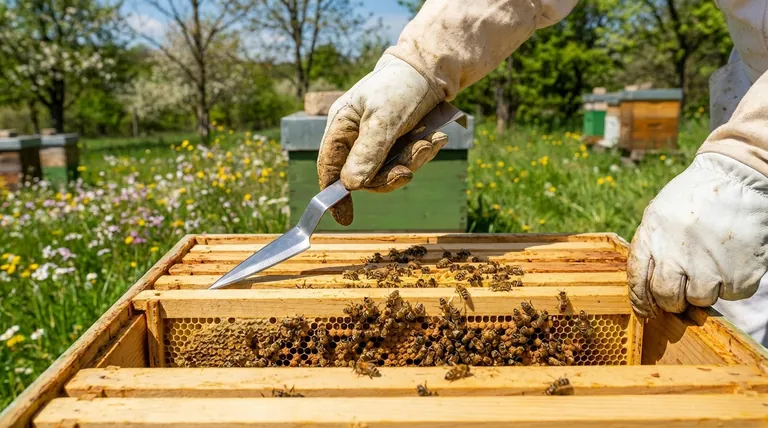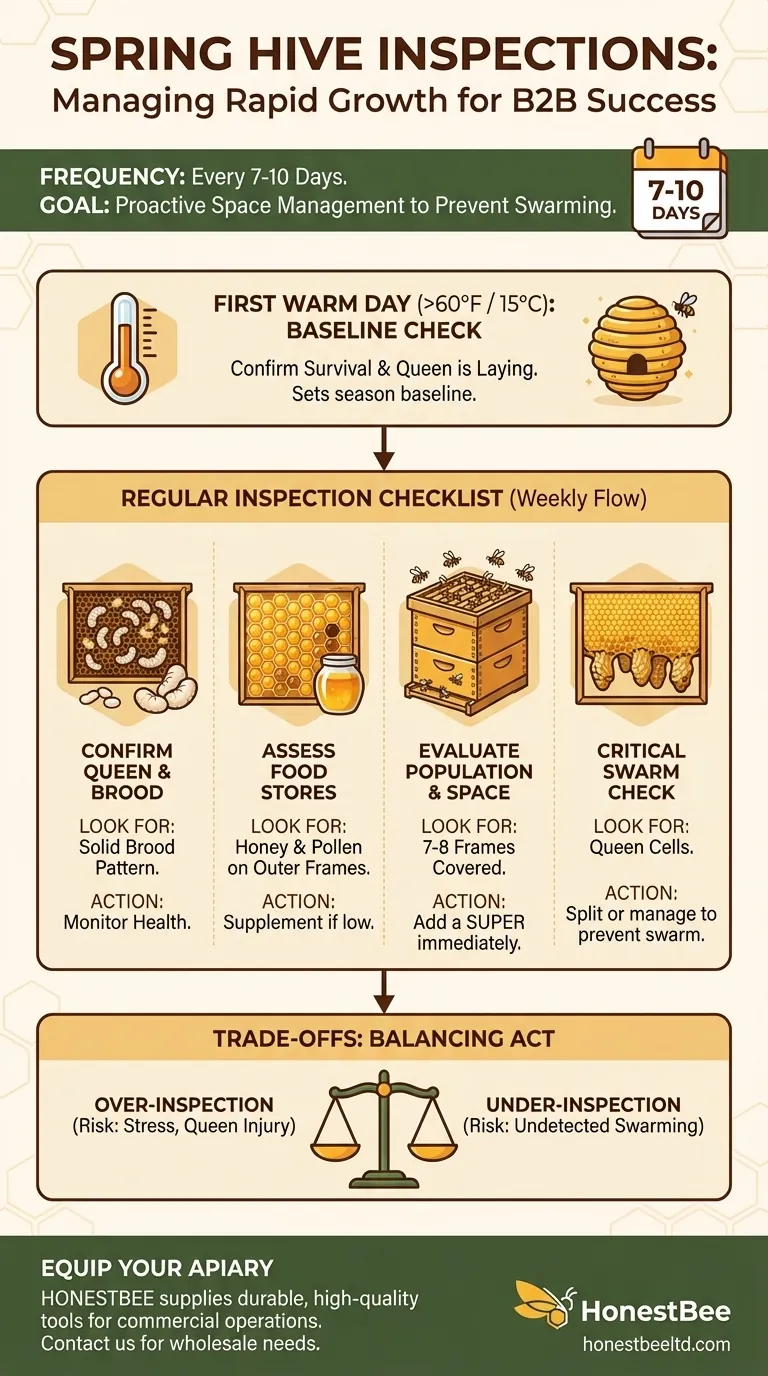In the critical spring season, you should inspect your beehive every 7 to 10 days. This frequency is essential for monitoring the colony's rapid expansion, ensuring they have enough space to build comb, and managing the natural impulse to swarm.
The core challenge of spring beekeeping is not just checking on your bees, but proactively managing their explosive growth. Your inspections are focused on providing space just before they need it, thereby preventing them from leaving the hive.

The Goal: Managing Rapid Spring Growth
Spring is a period of dramatic population increase inside the hive. The queen begins laying thousands of eggs per day, and the workforce expands rapidly to gather the abundant nectar and pollen. Your primary job is to facilitate this growth without letting the colony become overcrowded.
Why Every 7-10 Days?
This interval is directly tied to the honey bee reproductive cycle. Once the bees decide to swarm, they create new queen cells. It takes approximately 8 days for a new queen to go from a freshly laid egg to a capped cell, after which the swarm may depart.
Inspecting every 7 days ensures you can spot and manage these swarm cells before the colony makes the final decision to leave.
What to Look For on Your First Warm Day
Your very first inspection of the season, on a day above 60°F (15°C), is a simple wellness check. You are primarily confirming that the colony survived winter and that the queen is alive and laying. This initial check sets the baseline for the rest of the season.
Your Spring Inspection Checklist
During your regular 7-10 day inspections, your focus should be on a few key indicators of health and growth. Work efficiently to minimize disruption to the hive.
Confirm the Queen is Laying
You don’t need to see the queen herself. Instead, look for evidence of her work: a healthy brood pattern. This includes seeing eggs (tiny white specks at the bottom of cells), white C-shaped larvae, and capped brood cells clustered together.
A solid, compact brood pattern is the single best sign of a healthy, productive queen.
Assess Food Stores
The spring buildup consumes enormous energy. Check the frames on the outer edges of the hive to ensure the bees have enough stored honey and pollen. If stores are low, especially during a period of bad weather, you may need to provide supplemental feeding.
Evaluate Population and Space
Observe how many frames are covered with bees. A general rule is that when bees are actively using 7 or 8 of the 10 frames in a box, it is time to add another box (super) on top.
This is the most critical step in swarm prevention. Giving them space to expand upwards convinces the colony that they don't need to split and find a new home.
The Critical Swarm Check
Look for queen cells, which are the definitive sign of swarm preparation. These special cells are larger than normal worker cells, shaped like a peanut shell, and typically hang from the bottom of the frames.
If you see queen cells that contain eggs or larvae, the colony is actively preparing to swarm. You must take action, such as splitting the hive, to prevent losing half your bees.
Understanding the Trade-offs
Effective beekeeping is a balancing act. Both too much and too little intervention can cause problems for the colony.
The Risk of Over-Inspection
Every time you open the hive, you break the delicate propolis seal, disrupt the hive's temperature and humidity, and risk accidentally injuring or killing the queen. Inspecting more often than every 7 days can stress the colony and set back their progress.
The Risk of Under-Inspection
Waiting longer than 10-14 days between inspections is a significant gamble. In that time, a colony can easily fill all available space, build swarm cells, and depart before you even realize they were preparing to leave.
Making the Right Call for Your Hive
Use your inspection findings to guide your management decisions based on your specific goals.
- If your primary focus is swarm prevention: Your highest priority is identifying and managing queen cells within the 7-10 day window.
- If your primary focus is colony health: Prioritize confirming a solid brood pattern and ensuring the hive has adequate food stores on every check.
- If your primary focus is honey production: Be proactive about adding supers to ensure the bees always have ample space for incoming nectar, well ahead of their needs.
Proactive management based on regular, focused inspections is the key to a healthy and productive hive this spring.
Summary Table:
| Inspection Focus | What to Look For | Why It's Important |
|---|---|---|
| Queen & Brood | Solid brood pattern with eggs & larvae | Confirms a healthy, laying queen |
| Food Stores | Ample honey & pollen on outer frames | Supports rapid colony growth |
| Space & Population | 7-8 frames covered with bees | Signals time to add a super to prevent swarming |
| Swarm Check | Queen cells (peanut-shaped) on frames | Early warning sign of swarm preparation |
Ready to conduct your spring inspections with confidence? HONESTBEE supplies commercial apiaries and beekeeping equipment distributors with the durable, high-quality tools needed for efficient hive management. From smokers and hive tools to full hive setups, our wholesale-focused operations ensure you get the reliable equipment your business depends on.
Contact HONESTBEE today to discuss your wholesale supply needs and keep your colonies thriving this season.
Visual Guide

Related Products
- HONESTBEE Professional Long Handled Hive Tool with Precision Cutting Blade
- HONESTBEE Advanced Ergonomic Stainless Steel Hive Tool for Beekeeping
- Professional Dual-End Stainless Steel Hive Tool for Beekeeping
- Professional 3-Bar Frame Grip with Integrated Hive Tool
- Professional Galvanized Hive Strap with Secure Locking Buckle for Beekeeping
People Also Ask
- What tools are used for cleaning frames? A Beekeeper's Simple 4-Tool Guide
- What is a hive tool and what are its uses? Master Your Hive Inspections with the Essential Beekeeper's Tool
- What are some common uses of a hive tool? Essential Multi-Purpose Tool for Every Beekeeper
- Why do hive tools have a hole? Unlock the Secret to Efficient Beekeeping
- What is a hive tool used for in beekeeping? Your Essential Guide to Hive Management



















